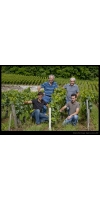Wine from Henri Gouges

The creation of Domaine Henri Gouges was the culmination of 400 years of family grape farmers, and it is, in many minds, the top domaine in Nuits-Saint-Georges. Henri formed the domaine in 1920 but was soon discouraged with selling the fruit to négociants. He envisioned a better quality wine, and by 1933, he was producing, bottling, and selling directly. He, along with the Marquis d’Angerville from Volnay, was at the forefront of battles against fraud in Burgundy in the 1920s. In the 1930s, Monsieur Gouges was one of the people charged with the job of delineating the crus in Burgundy for the Institut National d’Appellation d’Origine, and he was a member of that regulatory body at its outset. Since the beginning, the domaine has remained an undivided family property. In 1967 Henri’s two sons, Michel and Marcel, succeeded him and added to the holdings of the estate. Each of them handed leadership over to one of their sons to bring the domaine to the next stage. Pierre and Christian began the modernization of the vineyards and the winery, which they have now turned over to Pierre’s son, Gregory, and his cousin, Antoine. While the house style has evolved, the main focus is the better reflection of the terroir in the fruit through organic viticulture. They believe that healthy vines produce quality fruit and thus more expressive terroir-driven wines.
No products found
- back
Selected Options
Wineries
Categories
Pricing
Countries
Regions
Grape Types
Wineries
Organic/Free Shipping
We are delighted to offer our first Beckstoffer Georges III bottling in many years. The spectacular vineyard site with its back to the Silverado Trail is the historic site of the grand old BV masterpieces produced for most of the last century. It is as pure an expression of Napa Valley terroir as is available anywhere, from anyone. Ripe and round black fruits, spice, blueberry, and cedar, and cigar box aromas are echoed on the palate and balanced by a preternatural lift from natural acidity and a swell of earth notes. A stunning achievement.
Review:
Thick in sage brush, dried herb and earth, this wine is powerfully built and unabashedly ripe. Dark black fruit, mocha and graphite notes arise along the thick, intense palate, leading to finishing touches of slate and iron. Cellaring will help to tame the tannins; enjoy from 2028–2035.
-Cellar Selection Wine Enthusiast 94 Points
Dark plum in color with abundant aromas of dark chocolate, black cherry, and sun-ripened blackberry with a hint of cedar. Layered flavors of blackberry and raspberry pie filling, accompanied by notes of cinnamon, chocolate, and nutmeg play on the palate. Smooth and focused with refined tannins and a medium finish.




